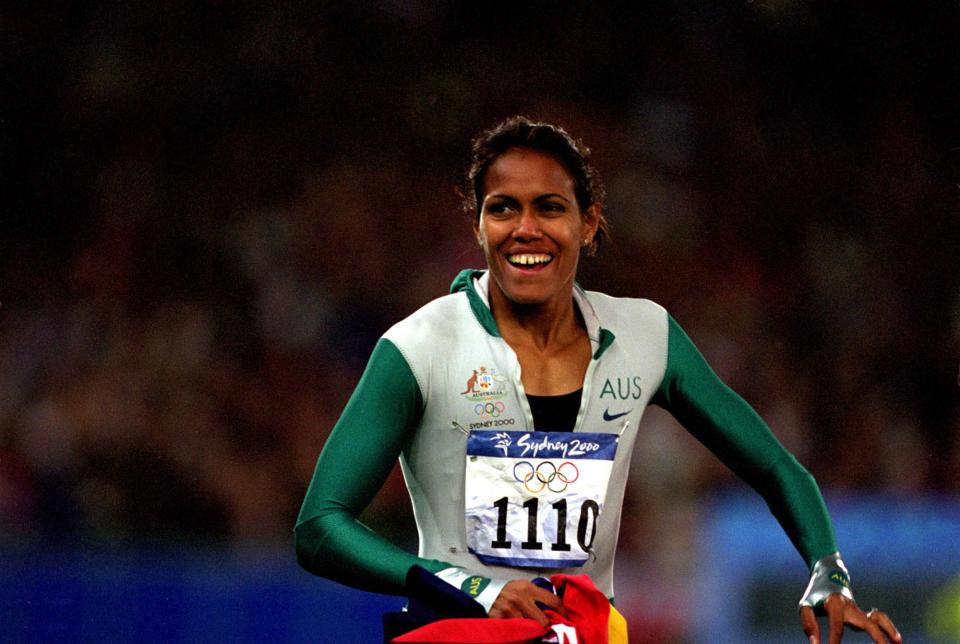Cathy Freeman’s Sydney 2000 gold was a moment of ecstasy at a time of national reckoning

In 1968, I was about to turn 11. Our family was living on a public housing estate in Richmond, consisting of row upon row of low-rise flats. I came from a boxing family. My great uncle, Les Moodie, had been the Australian bantamweight champion during the first world war. My father loved boxing and had taught his children, including his daughters, to fight. On a warm February night of that year, our family huddled around a radio and listened to the broadcast of the world bantamweight title fight, from Tokyo. The defending champion, Masahiko “Fighting” Harada was up against the great Aboriginal boxer Lionel Rose.
Related: Cathy Freeman’s 400-metre Olympic gold voted Australia’s greatest sporting moment
My father loved Rose and had closely followed his career. The tension in my father’s body was on display that night. He leaned forward in his chair throughout the bout, ducking and weaving in support of his hero. At the end of the fight the judges’ cards were tallied and Rose was declared the winner. A roar exploded across the estate, in each family flat, throughout every building. The moment was euphoric, a celebration I doubted I would ever experience again – until a September night in 2000.
The pressures on Cathy Freeman to succeed at the Sydney Olympic Games were multifaceted and beyond what any spectator could comprehend. Her rise on the track in the years leading up to the Games indicated she was primed for the 400m event. She’d won a silver medal at the 1996 Olympics, and dual world titles in the same event in 1997 and 1999. But as any elite sportsperson realises, while partisan crowds offer energetic support, the pressure of performing on home soil can be overwhelming.
Freeman had more to deal with than her athletic performance. She was not only one of Australia’s premier athletes at the time – she was also a young Aboriginal woman from regional Queensland, thrust into the glare of public opinion at a time when race relations and a history of colonial violence dominated political discourse in this country. Following the release of the human rights and equal opportunity commission’s Bringing Them Home report in 1997 – an extensive document dealing with the history of the stolen generations of Aboriginal children – Australia was divided between those who sought strategic amnesia to deal with history, and those who believed in a need for what we now refer to as “truth-telling”.
Related: Cathy Freeman’s 2000 gold was a landmark in every measure of Australia’s history | Jonathan Horn
A few months before the Sydney Olympics, on 27 May, many hundreds of thousands of people had marched in streets across Australia in support of reconciliation. While we continue to debate the legacy, ideals and practical opportunities of reconciliation today, the fact remains that on the evening of 25 September, Freeman stepped up to the starting blocks for the 400m final in front of 110,000 people, bearing a weight that few others could have carried to the finish line.
Several moments from that night remain with me, with a clarity that never requires me to check a replay for validity. Freeman’s one-piece running suit provided a remarkable image. It was as though this Aboriginal woman, grounded in the country of her family and ancestors, might also be from another place – Planet Freeman! While two or three other runners remained competitive throughout the race, they seemed to vanish from the track as I watched. Freeman was alone, striding with such elegance between white lines that she appeared to be running effortlessly (which, of course, was not the case).
At the end of the race, I felt just as I did the night that Rose won his own title. Aboriginal and Torres Strait Islander people across the country were ecstatic, as were most Australians. It has been said many times since that a burden was lifted from Freeman that night – I doubt this very much and have never heard her speak about the night in such a way. Just watch Freeman’s face as she drops to her knees after the race. Rather than letting go, or relieving herself of pressure, she appears to draw her energy inwards, gathering strength and culture.
During Freeman’s lap of honour, she carried the Aboriginal and Australian flags on her back. It is both a cliche and a reality to recognise the symbolism of the gesture. She did represent her own people, from her beautiful mother, Cecelia, to those who have come before her. And willingly or not, she also represented a nation floundering with the concept of hope during a period of political volatility. But what we must also remember, and give attention to, is that on 25 September 2000, Cathy Freeman became one of the greatest athletes to ever walk on to a running track.
Tony Birch is the author of the novels Women & Children, The White Girl, Ghost River and Blood

 Yahoo Sport
Yahoo Sport 





































